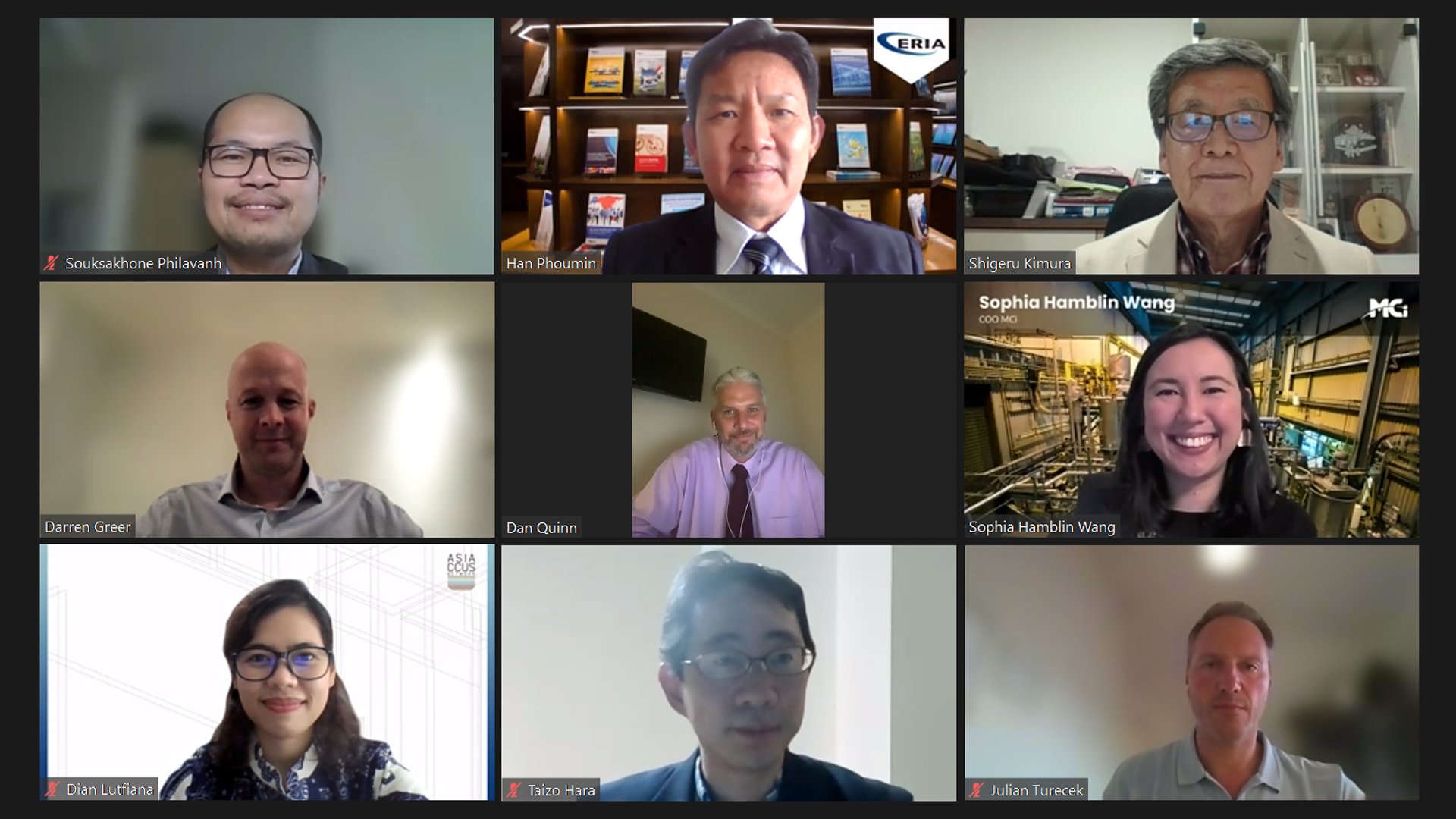Australian Stakeholders Showcase CCUS Possibilities to Asian Region
The 5th Knowledge Sharing Virtual Conference, 28 February 2022: Australia’s commitment to reaching net-zero emissions and its green technology advancements have shown the various possibilities of carbon-neutral technologies for the Asian region. In line with Asia and ASEAN’s net-zero goals by 2050, Carbon, Capture, Utilisation, and Storage (CCUS) technology is an option of the Australian government’s carbon dioxide (CO2) reduction plan. The Australian government and three guest speakers from Australia joined the Economic Research Institute for ASEAN and East Asia (ERIA) – the secretariat of the Asia CCUS Network (ACN) – during the 5th ACN Knowledge Sharing Conference. The speakers shared their vision for CCUS technologies in Asia as well as their work to contribute toward a carbon-neutral world.
In his opening remarks, Mr Taizo Hara, Director General of Research and Policy Design Administration of ERIA explained the difficulties developing countries may face in decarbonising given that fossil fuel is a mainstay for many nations. Although ASEAN and Asia have pledged their commitment towards carbon neutrality by mid-century, Mr Hara stated that ‘the pathway to zero emissions will come at a cost’ with green technologies such as CCUS and direct air capture (DAC) remaining costly. Mr Hara ended his speech by highlighting the role a developed green technology value chain in the Asia region can play in ensuring affordable decarbonisation pathways for Asia.
Mr Dan Quinn, General Manager, Resource Strategy, Onshore Resources Division, Department of Industry, Science, Energy and Resources, Australia shared policy insights regarding the Australian government’s decarbonisation efforts. In his speech, Mr Quinn emphasised the value of collaboration for Australia as the country strives ‘to increase global cooperation and engagement with like-minded countries and regional partners’ to make low-emissions technology accessible. Australia is currently developing a National CCUS Tech Emissions Abatement Strategy to contribute to the portfolio of CO2 reduction innovation so the country meets its mid-century goal. Another effort is the government’s AUD 300 million support for CCUS advancements in which AUD 50 million have been allocated to the CCUS Development Fund and AUD 250 million designated for hubs and technology programmes to facilitate commercial-scale deployment of CCUS projects and hubs. Mr Quinn concluded his speech by touching upon Australia’s intent to expand its domestic CCUS capacity while contributing to carbon storage solutions.
Dr Han Phoumin, Senior Energy Economist, ERIA was the moderator of the Presentation Session on the ‘Introduction of Australian CCUS Projects: Direct Air Capture, Carbon Recycling and CO2 Storage’ expressing that Australia’s proximity to Asia makes their experiences significant as it can apply to Asian countries.
The first presenter Mr Julian Turecek, Executive Director/ Project Director, Direct Air Capture (DAC) Corporate Carbon shared about the company’s AUD 4 million grant from the Australian government for its work that Mr Turecek said is ‘to be the first in the world to demonstrate solar power DAC through to geological storage.’ Together with Australia’s Southern Green Gas, Corporate Carbon is developing a solar-powered DAC technology, meaning it is entirely powered by renewable energy hence making it emissions-free and fossil-fuel-free.
On carbon storage potential, Corporate Carbon has already identified several sites to capture and store 20 billion tonnes of CO2 that can be utilised to produce building materials or synthetic and sustainable fuels. Ultimately, the main objective of the DAC industry is to push the price of carbon removal as close to USD 100 per tonne of CO2 compared to the current range of USD 500 – USD 1,000 per tonne. Mr Turecek stated that the scaling-up of decarbonisation projects would support the feasibility of the USD 100 tonne per year objective by the end of the decade.
Ms Sophia Hamblin Wang, Chief Operating Officer, Mineral Carbonation International (MCI) showcased the remarkable ways CO2 have been utilised to produce low-emissions or negative-emissions physical goods in her presentation. MCI is another Australian government grantee selected for its work on integrated carbon solutions. To date, MCI has produced plasterboards and cement blocks for a wide range of renowned clients though Ms Wang mentioned that they can also produce low-emissions sea walls, carpet, paper, and glass. In essence, MCI has proven that profit generation through decarbonisation is possible to accomplish and that such technology can be scalable thus promoting the carbon recycling process.
The final speaker, Mr Darren Greer, General Manager of Carbon Transport and Storage, a Glencore Company (CTSCo) talked about the technical viability, integration, and safe operation of CCS in the Surat Basin in Queensland. CTSCo’s CO2 post-combustion capture plant at the existing Millmerran power station is expected to inject the first CO2 into the reservoir in 2024 if the company receives Queensland’s environmental approval for the storage process. The storage license area is around 3,700 square kilometres and is strategically located to existing transportation infrastructure complemented with existing oil and gas pipelines and pipeline routes. The demo-scale plant is poised to capture 110,000 tonnes of CO2 annually although CTSCo is also exploring cases where it can inject 10 million tonnes of CO2 per year for over 30 years into its storage area.
CTSCo estimates that the average cost of carbon storage could range between AUD 13 – AUD 17 per tonne of CO2 – a figure that is lower than the Australian government’s AUD 20 target. The cost is based on an assessment of the Greenfield project which can store 2 million tonnes of CO2 per year and is equipped with a 100-kilometre pipeline. Mr Greer emphasised that one of the company’s objectives for the project is to ‘verify a large-scale CO2 storage basin that can be used by industries’ which he finds is ‘important for people to invest in capture technology in the future.’ Essentially, the demo-scale project acts as the foundation for future large-scale storage infrastructures.
Mr Souksakhone Philavanh, Director of Energy Law Division, Department of Law, Ministry of Energy and Mines, Government of the Lao PDR led the Commentary Session where he praised Australia for making strides in carbon neutrality. Unlike Australia, Lao PDR has found the net-zero transition more challenging, which Mr Philavanh attributed to the country being landlocked and having a mountainous terrain. This has made finding a potential storage area difficult on top of additional issues such as poor road conditions and limited transportation, further complicating Lao PDR’s desire to reduce its annual 40 million tonnes in CO2 emissions.
Mr Philavanh posed questions to the guest speakers including one to Mr Turecek about the environmental concerns of DAC. Mr Turecek admitted that such a matter has not been given a lot of thought in the context of DAC, however, if there are any concerns, those in the carbon capture industry in Australia and globally must quickly resolve it. Mr Turecek underlined that no energy source is perfect, thus stakeholders must identify an energy source with the smallest footprint possible.
Mr Philavanh asked Ms Wang about MCI’s technology and its business model. She explained that there are three key factors needed for MCI’s technology to be successful, namely CO2 source, mineral feedstock, and a local market. Ms Wang stressed that those three factors must be within 100 kilometres of each other to make a profit and for the carbon economics to work.
Mr Philavanh inquired about integrating CTSCo’s technology into Lao PDR’s sole coal-fired, 1,800-megawatt power plant and an upcoming 900-megawatt power plant to Mr Greer. Three crucial aspects are needed for a post-combustion power plant: CO2 or flue gas, a system to return the lean gap flue gas to the power plant, and steam. Mr Greer finds that the advantage of a post-combustion power plant is that it is a module of technologies hence governments and companies can gradually scale up.
Guest speakers also participated in the Open Discussion Session where participants had the chance to ask questions. Concerning the commercialisation of DAC, Mr Turecek said that Corporate Carbon is aiming to commercialise the first project in the southern hemisphere by 2030. The company will gradually scale up from 1,000 tonnes of CO2 per year to 1,000,000 tonnes of CO2 per year by the end of the decade in a bid to realise the AUD 100 per tonne scenario for carbon capture costs. Mr Greer answered inquiries on the monitoring of a carbon storage site which is an aspect he assures has a significant part of CTSCo’s demonstration project. He said the company adopted monitoring techniques such as timelapse seismic and monitoring wells with fibre optics.
Ms Wang responded to questions regarding MCI’s carbon footprint reduction aspect and government regulations concerning the company’s products. She stipulated that different products and materials result in different footprints. Moreover, MCI’s plan to erect a CO2 processing plant to capture 1,000,000 tonnes of CO2 per year is projected to generate $100 per tonne of CO2 in profit for the company. Ms Wang stipulated that the carbon utilisation industry and ecosystem are still unfolding, but MCI continues to work ‘with large material and mining companies to validate the safety and environmental efficacy of our products.’ She underscored the necessity to create a proper framework around the safety of the products ‘because we need all technologies in the CCUS field to have integrity, safety, and to be truly low emissions or negative emissions.’ Dr Phoumin closed the discussions by mentioning how the different carbon sink technologies reflect the many complementary pathways to CCUS deployment and reaching the net-zero target by mid-century.
Mr Shigeru Kimura, Special Advisor to the President on Energy Affairs, ERIA gave his closing remarks touching upon the role of the Australian government in driving the ongoing successes of the country’s CCUS activities. Japan and Australia’s participation in CCUS present ASEAN with the opportunity to follow suit as Southeast Asia currently have no such projects. Mr Kimura also explained that ERIA and ACN would be striving to set up a CCS or CCU pilot project in ASEAN by 2025 which would refer to the developed countries’ expertise and experience in CCUS technologies including DAC and carbon recycling. Mr Kimura thanked the guest speakers for their contributions adding that their respective initiatives are interesting for Asian and ASEAN countries.

